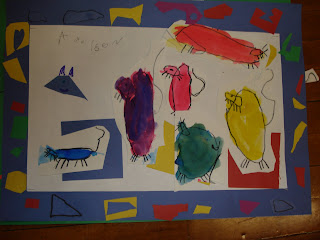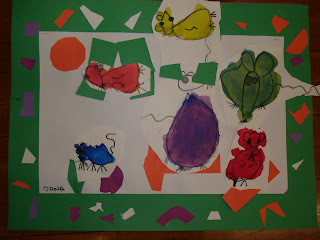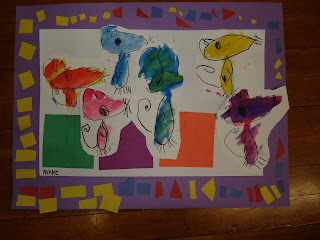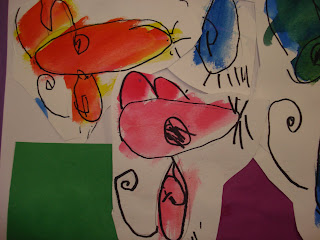
Following a lesson on Piet Mondrian and primary colors, I introduced my kindergartners to the book 'Mouse Paint by Ellen Stoll Walsh. This is a really well known book for young children, it could easily be used for a pre-k lesson as well. I've also seen this lesson done a couple of different ways, all with successful result. The way I did it, the lesson took about 5 sessions. Admittedly, I made the lesson slightly harder than it had to be, having the students draw all their mice first, but I think it was a good learning experience for them and the finished mice really show their personalities. Here's how I did the lesson;
Day 1: I used guided drawing to show the students how to make mice in 3 different poses using tear-drop shapes. At first they practiced on white boards, and then when I saw they all felt comfortable, I had them begin drawing their mice on white paper.
Day 2: The students finished drawing their mice and then traced them in sharpie, erasing all the pencil lines underneath.
Day 3: We reviewed the primary and secondary colors, after reading the book and then I put a pdf image i made showing the color formulas on my visualizer. The students had to begin by painting the 3 primary colors first in watercolor paint.
Day 4: They mixed the secondary colors and painted them. They cut out all their mice and began creating 3 primary or secondary colored 'jars' out of construction paper, to have as a background for their mice. Just like in the story.
DAy 5-6: The students finished their backgrounds and then I stapled a colored paper border around their work which they began decorating. I emphasized the creation of a pattern for their border design, but did not require them to adhere to one.





All in all they did a great job, but the lesson was a bit tedious, I've seen and read about it being done different ways. For instance, there is a fellow blogger who did a Mouse Paint lesson and had the students paint the circle first and then had them draw the mice around the circles, which is really much more practical and equally (if not more) effective than what I did. Here are a few other images I found when I was 'googling' ideas for how to use the book! If you have done a lesson on Mouse Paint leave me a comment and I'll edit in a link to your page, especially if one of the images I've put up here or mentioned is yours I'd like to include your name in the post.
Hampstead Academy Artsonia Page
Libraryarts.com
Person/teacher/site unknown


Person/teacher/site unknown
 art-paper-scissors.blogspot.com
art-paper-scissors.blogspot.com 'One Crayola Short'
'One Crayola Short'


























